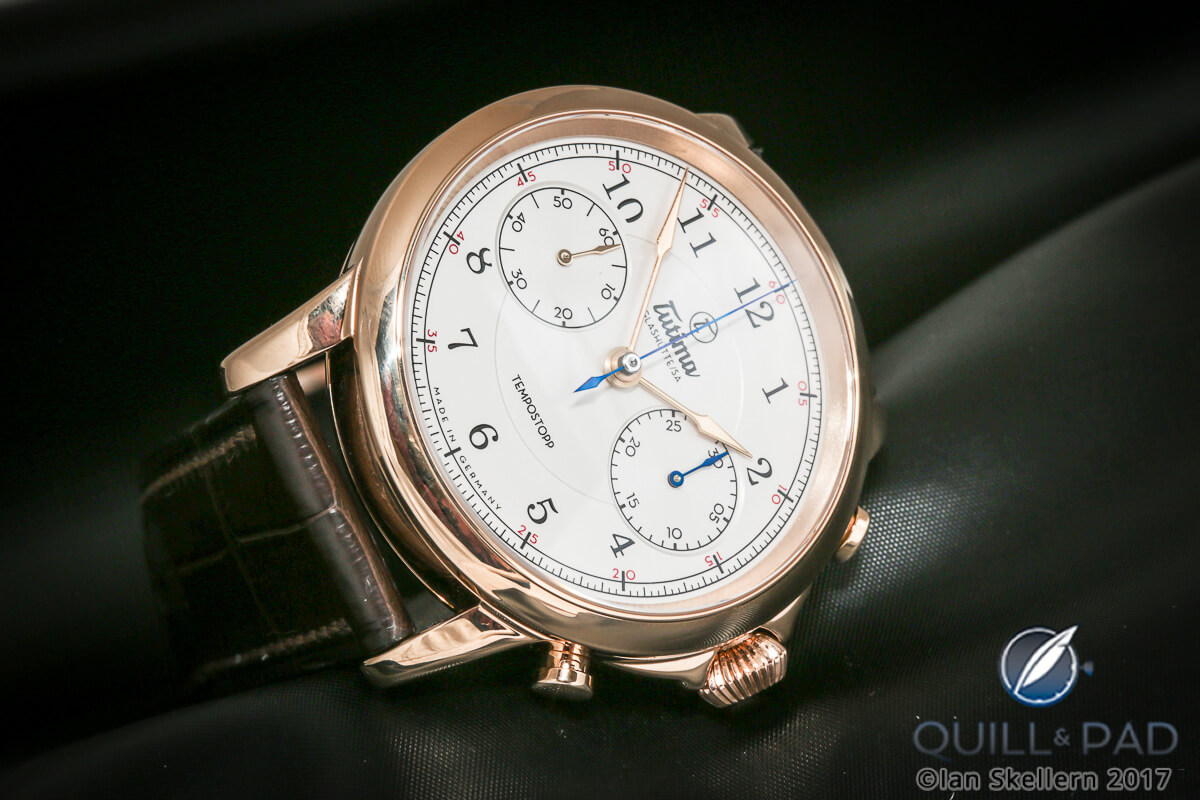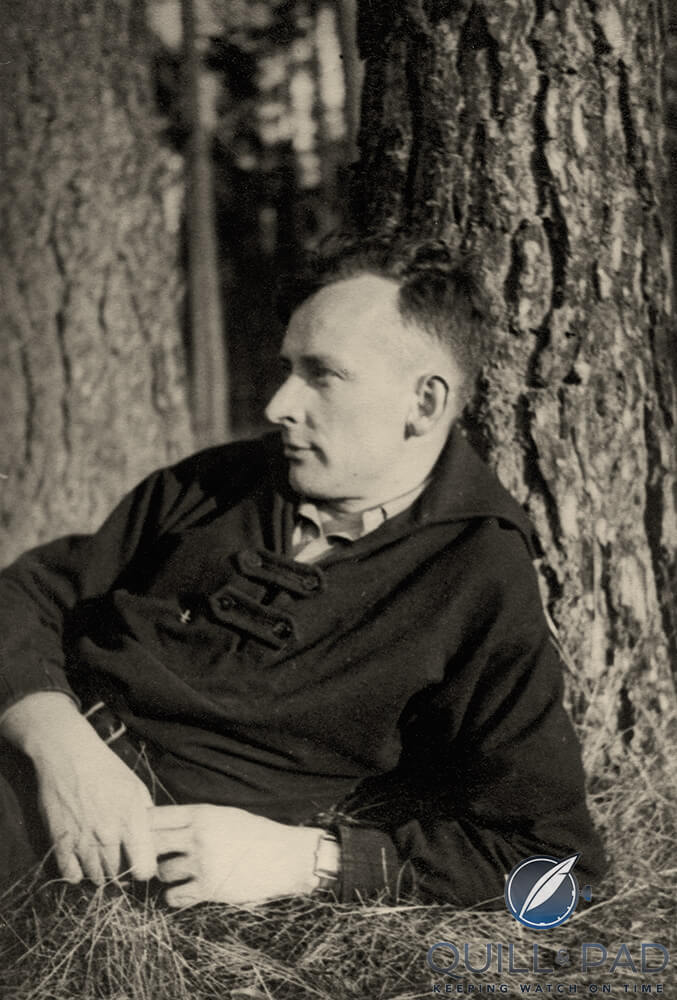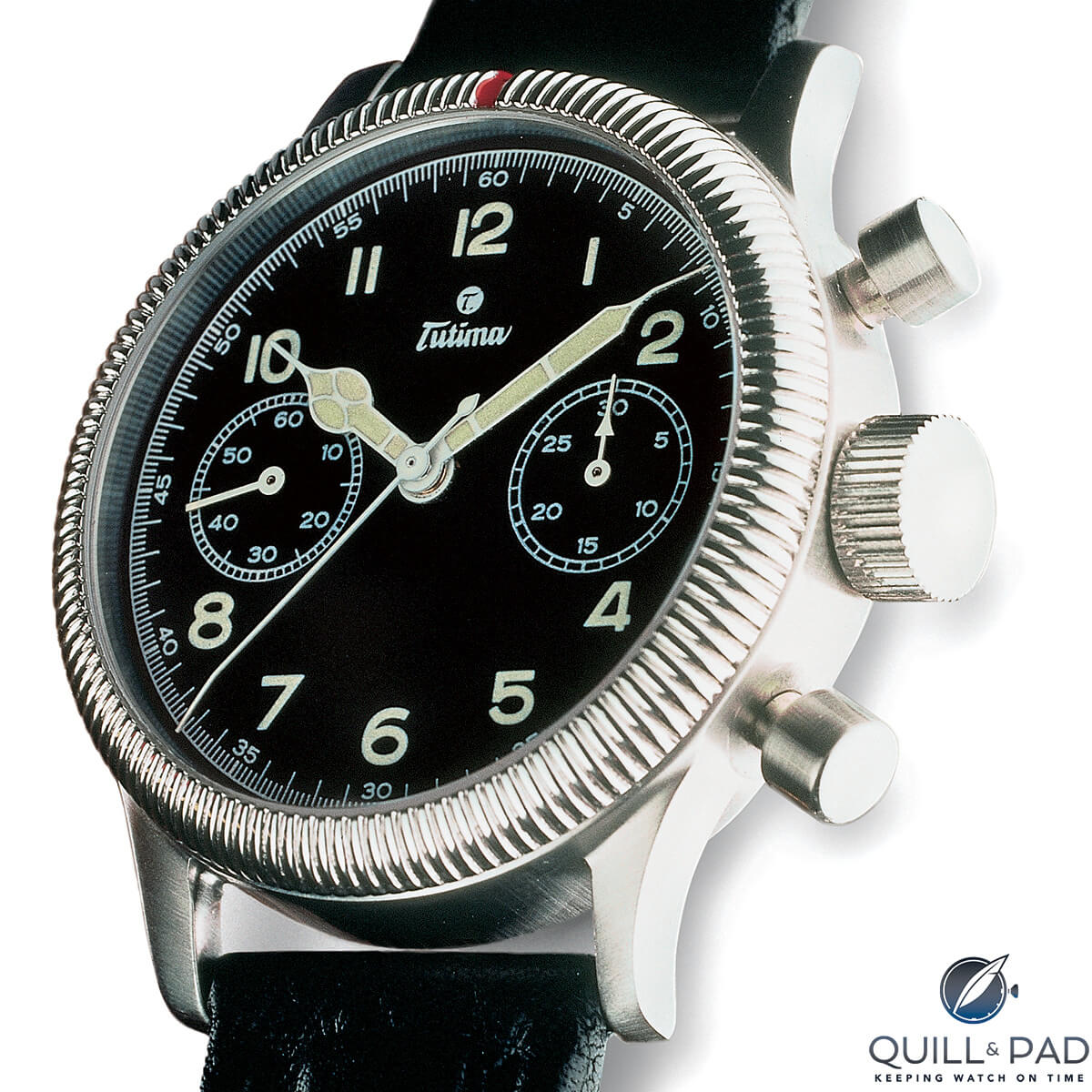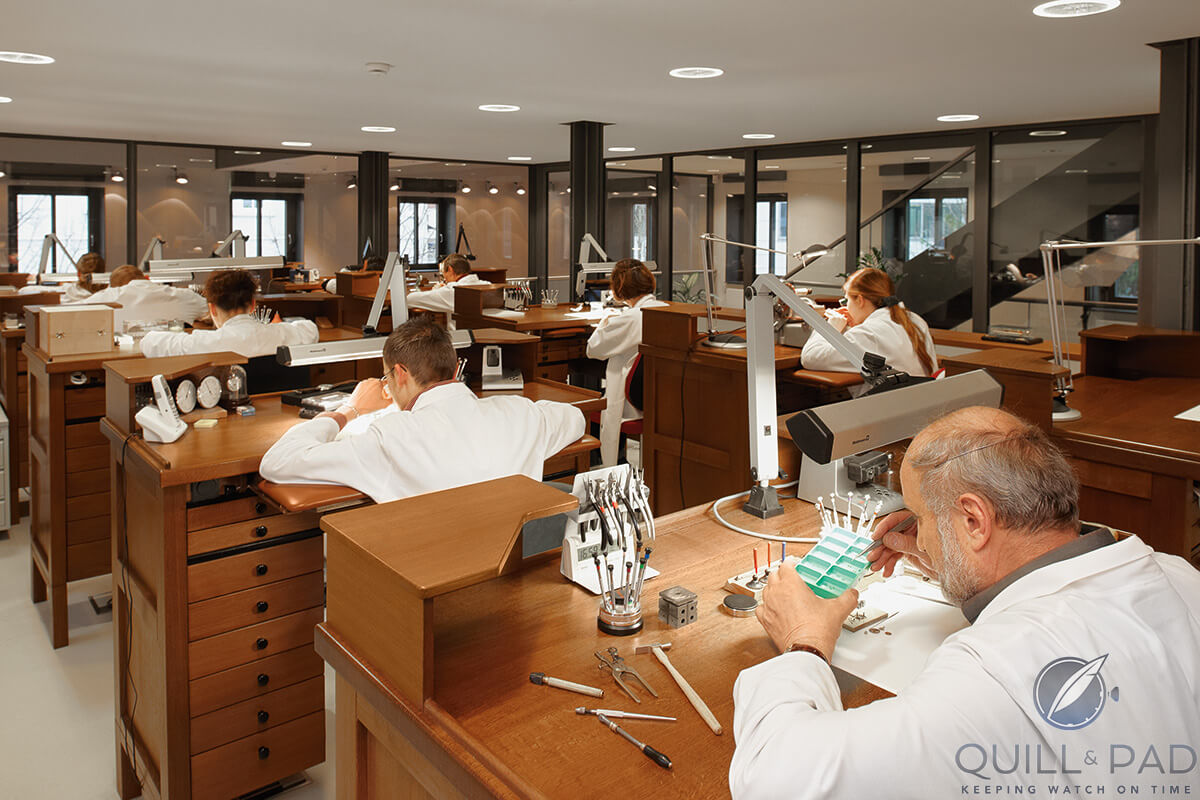90 Years Of Tutima: An Abbreviated, Complete History
The history of Tutima is inextricably linked to the history of Glashütte, the German city whose watch industry was founded in 1845 by Ferdinand Adolph Lange.

Tutima Tempostopp flyback chronograph
Although Tutima’s roots don’t extend back quite that far, its story begins in 1927 as it rose from the ashes of Glashütte’s Deutsche Präzisions-Uhrenfabrik (DPUG), which had been founded in 1918 to manufacture and distribute primarily precision pocket watches with the express goal of competing with the newfangled machine-made Swiss watches.
The late 1920s were tough on a lot of areas in Germany, and Glashütte was no exception. The DPUG collapsed under the weight of the skyrocketing inflation: in August 1922 a hunter pocket watch cost 22,500 German marks, but five months later it cost nearly five times as much (105,000 marks).
Still, the DPUG’s general director continued to purchase machinery and manufacture old-fashioned pocket watches. But by 1923, inflation was exploding: in November 1923, that same pocket watch cost 109,000,000,000,000 marks.
Finally, the financial system broke down and in 1925 DPUG’s buildings and machines were repossessed and auctioned off.
By 1927, Glashütte had had its fair share of ups and downs – mostly downs after World War I – but its watch industry continued toiling under the motto “never say die.”
A new Glashütte epoch: Dr. Ernst Kurtz and Ufag/Urofa
Enter the enterprising Dr. Ernst Kurtz, a jurist originally from Hamburg, who created the legendary Glashütte watch factories Urofa (Uhren-Rohwerke-Fabrik Glashütte AG) and Ufag (Uhrenfabrik Glashütte AG) from the bankrupt carcass of the DPUG. Dr. Kurtz had a good feel for how these companies should be run, and the economic upswing of the 1930s helped the two factories establish themselves in an ever more competitive market.

Dr. Ernst Kurtz and his development team in Glashütte’s Ufag factory in 1939
Ufag/Urofa’s production methods were conceived along erstwhile Swiss methods – using automated manufacturing techniques, new in the 80-year-old Glashütte watch industry. This was necessary to stay competitive as Glashütte was in danger of becoming irrelevant due to its unwillingness to concentrate on manufacturing the more modern and much more fashionable wristwatches.
While Urofa concentrated more on manufacturing ébauches (raw movements), Ufag produced finished wristwatches, and its top brand Tutima became a synonym for quality. At the end of 1938, the government integrated the two factories into the armament industry and by 1940 they had completely stopped manufacturing civilian wristwatches and did not restart making them until the end of the war.
The original Tutima Glashütte pilot’s chronograph
In 1939 the companies began planning for what would become one of Glashütte’s most famous watches: the Reich’s air force watch or what we call today the original Tutima Glashütte pilot’s chronograph. The war, the ministry of defense, and the factories themselves demanded that this pilot’s chronograph be an especially reliable one. The prerequisites for this watch were laid out precisely defined in the ministry’s strict spec booklet.

Original 1940s Tutima pilot’s chronograph outfitted with Caliber 59
This pilot’s chronograph had to be resistant to shocks, high acceleration (diving planes), and pressures of up to 1.5 atmospheres for at least an hour and a half. Even its rate performance was exactly defined: –3 to +12 seconds in a temperature range of -10 to +40 degrees Celsius.

Original 1940s Tutima pilot’s chronograph
Thus the first Tutima pilot’s watch in series was created, a now-classic timepiece boasting a striking fluted bezel and featuring a conspicuous red reference marker on an extra-large fluted case with a very large crown, ergonomic chronograph buttons, and a large, legible dial marked with luminescent elements for maximum night-reading capability. This pilot’s watch also featured a flyback function, which was known as a “tempostopp” in old German watch parlance.
Between 1941 and 1945 about 30,000 Tutima pilot chronographs were manufactured, most of which were used as the official watch of the German Reich air force’s military pilots. Urofa created a brand-new caliber for it, the manually wound Caliber 59 featuring a 30-minute chronograph counter, flyback function, column wheel switching, monometallic screw balance, a Nivarox Breguet balance spring, and shock protection. Measuring 34 x 5.4 mm and outfitted with 17 jewels, Caliber 59 was the first German chronograph with flyback function.
Kurt Herkner’s book Glashütter Armbanduhren Band II describes the movement’s wheels, pinions, and case as having been imported from Switzerland. Caliber 59 was only used for this one model and never sold to other manufacturers, though it was produced in three finishes: silver-plated frost covered with gold plate; silver-plated frost; and nickel plate.

Walter Kurtz (right), test pilot for the German air force and brother of Dr. Ernst Kurtz
Kurtz’s brother, Walter Kurtz, happened to be a test pilot for the Reich’s air force, and so it was that the watch was literally continually tested under genuine conditions before it was sent to war.
After World War II
On May 8, 1945, just scant hours before the official end of World War II, Glashütte was bombed one final time and the Russians made sure that all of the “military installations” were leveled. Any facilities that survived the air attack were dismantled and transported back to the Soviet Union, including the contents of Urofa and Ufag. Herkner describes this taking place as of July 1, 1945. By August 8, the factories’ rooms were entirely empty.
All blueprints for Caliber 59 were lost at this time.
Although this was an unthinkable shock, and one that set Glashütte’s watch industry back several years, it was not the worst catastrophe to befall the idyllic Saxon town in the 1940s. Following the bombing, Glashütte’s inhabitants in their infinite optimism got right back up, dusted themselves off and rebuilt their industry.
Kurtz, who may have had a premonition of the socialist years in store for eastern Germany in addition to the final day of bombing, left for Franconia, a German region bordering Saxony (that remained part of West Germany) just scant days before, taking a number of qualified Glashütte tradespeople with him.
Kurtz took over a former assembly factory for the Glashütte industry now situated in the town of Memmelsdorf, as both Urofa and Ufag had been dismantled by the Soviets. Kurtz’s first task was for the U.S. Army: to reassemble the remaining stock of Caliber 59 that had been salvaged.
Around 1951, Kurtz set his course on northern Germany, finally settling in Ganderkesee, near Bremen, and began to produce watches signed Kurtz Glashütter Tradition. Manufactured with knowledge born and bred in Glashütte, by all accounts his Kurtz Caliber 25 was especially noteworthy for its high quality.

Dr. Ernst Kurtz
A short five years later Kurtz once again ran into financial trouble due to the rising competition from less expensive, mass-produced wristwatches from Switzerland, and his employee Werner Pohlan took over the company. Pohlan, who renamed the company Nurofa (adding the German equivalent of “north” to the original Glashütte name), also reactivated the brand name Tutima during his time as company head.
Around 1960, Dieter Delecate, a co-worker of Pohlan’s and close confidant of Kurtz, who had founded a company distributing Tutima’s products, entered the scene with a serious offer for taking over the company’s production.
And so it was that Delecate, a businessman from northern Germany, now controlled the destiny of one of Glashütte’s most renowned brands.
The Delecate family
Delecate reorganized the company to become Tutima Uhren GmbH. His time at the enterprise’s helm in the 1960s and ҆70s was not easy – his fiercest battle at this time was fought against the mighty quartz wristwatch invasion from the Far East. By continually adapting and modifying structural and model policies, and never letting go of the original enthusiasm that led him to acquire the factory in the first place, Delecate was able to keep his head above water during a period in the wristwatch’s history that caused many other traditional names to throw in the towel.

Dieter Delecate
However, mechanical watch connoisseurs did not need to wait long for Tutima’s return to complicated mechanics. In 1985 the German army contracted Tutima to create a brand-new military watch, and Military Chronograph 798 was born. It has been part of the standard equipment for Bundeswehr (German armed forces) pilots ever since.
The military prerequisites of Military Chronograph 798 were even stricter than those of the pilot’s watch of 1941. The movement was based on a Lémania caliber, as Tutima was no longer set up to manufacture mechanical movements. Its four-Hertz balance had to be within a rate tolerance of –2 to +8 seconds in 24 hours and (now in the jet era) it had to withstand accelerations of 7 Gs .

Tutima Reference 798-02 Military Chronograph
Inspired by the success of Military Chronograph 798, one of the first high-profile timepieces to be produced after the quartz shock, and spurred on by the general renaissance of mechanical watches in the late 1980s and early ҆90s, Tutima decided to do something very few brands had thought of until that point: a reproduction of the original 1941 pilot’s watch.
Basing the movement on the hand-wound, tried-and-true Valjoux 7760 (the original caliber was obviously no longer available as previously explained), Tutima’s 1941 “replica” entered the market in 1994, just in time to celebrate the 95th birthday of Dr. Kurtz, who passed away only in 1996 in Ganderkesee at the age of 97.

Tutima’s “1941 re-edition” of 1994, later known as the Tutima Grand Classic Flieger chronograph; this is still a Tutima collection classic in various forms
The only thing that the Valjoux 7760 couldn’t do that Urofa’s Caliber 59 could was capable of was to integrate the flyback function (which German’s sometimes call “addition timing”). And the only real change to the appearance of the watch was the replacement of the crystal: instead of a more original Plexiglas crystal, Tutima chose to use sapphire crystal to increase the overall value and robustness of the timepiece.
The classic outer design of the watch was duplicated in every other way, making this timepiece a standout in the contemporary European watch scene of the mid-1990s.
Delecate says of Dr. Kurtz that, “he was an idealist. He always spoke of Glashütte and made great plans. It’s too bad that he couldn’t reach his goals during his lifetime.”
Delecate was always intent on carrying on in Dr. Kurtz’s shoes, something he himself has now done for nearly six of the nine decades the company has been in existence. The trend toward multi-functional mechanical watches was very good for Tutima, which then specialized in pilot’s style timepieces, particularly chronographs.
Tutima made professional instruments used by governmental institutions such as the German Bundeswehr and AWACS, a NATO aviation group, as well as private aviation groups such as Sean D. Tucker’s Power Aerobatic Team, which became popular with both German and American watch collectors.
Titanium pioneer
One other thing that many might not realize is that Tutima was also an early proponent of the use of titanium in mechanical watches. A dark silver-white in color, titanium alloy was the lightest metal in use for wristwatches at the time. Robust, yet attractive – lightweight, yet exceptionally tensile, even at high temperatures – titanium alloys are used in the construction of air- and spacecraft, naval ships, guided missiles, and lightweight armor plating on tanks.
This exceptionally corrosion-resistant, low-density alloy is ideal for large wristwatches.

The Delecate family from left to right: Dieter Delecate, Ute Delecate, and Jörg Delecate at the Glashütte factory opening in 2011
It goes without saying that modern Tutima timekeepers are most associated with aviation – they are pilot’s watches and Tutima’s marketing has reinforced this association.
Delecate’s two children, Jörg and Ute, both joined Tutima in managerial positions after completing their university degrees in economics.
And Jörg and Ute’s positions ensure that Tutima will remain in the hands of the family for at least one more generation. Delecate reports that he and his children often brainstorm together. “We get along well together and love to give ourselves challenges. We often solve things together. Working together with family members enables us to take more of the initiative and practice our brand of idealism.”
Regarding the marketing, “we think up these ideas ourselves.”

Sean D. Tucker, famous aerobat, flying his Tutima-emblazoned plane over California; Tucker is Tutima’s longest standing and most involved marketing ambassadorship (photo courtesy Jessica Ambats)
The fall of the Berlin Wall and subsequent German reunification in 1989 changed a lot of things in Germany. And even more in Glashütte.
I outlined this groundbreaking event in How The Wall Came Tumbling Down: Made In Germany.
While some other brands opened and re-opened for business in Glashütte earlier than Tutima, it wasn’t surprising that Dieter Delecate chose to bide his time for a move back to the German Mecca of watchmaking: ever the careful and considered man, he wanted to ensure everything was as close to perfect as it would ever get.
In 2005 the family bought the property formerly housing the region’s railroad maintenance crew and began renovations of the building, which were only completed in 2008. “This was a strategic decision for us,” Delecate confirmed at the time, not wanting to comment further.
Then in 2008, Delecate hired Rolf Lang, a cornerstone of modern Saxon watchmaking: not only has he served as chief restorer for the Mathematics Physics Salon located in Dresden’s Zwinger – which houses one of the widest and most important collections of historical timekeeping instruments – but he has also held the chief position of restoration and special projects at A. Lange & Söhne and was production head for Moser & Cie. before moving to Tutima Glashütte.

The new Tutima headquarters and factory in Glashütte
But it wasn’t until May 12, 2011 that Delecate’s banner day arrived as the new Tutima Glashütte needed time to carefully consider and perfect its ticking homage to the history of the company. “This day is one of particular honor for me,” he said, welcoming guests to his brand-new factory.
Despite Tutima’s great success in the era of the mechanical renaissance thanks to Delecate’s clever emphasis on the pilot’s chronograph, two sore points had remained throughout the years: the displacement of his company’s historical location and the compelling use of third-party chronograph movements.

Dieter Delecate welcoming guests to the Glashütte factory opening in 2011
May 12, 2011 represented the fulfillment of half of Delecate’s goals: after an absence of 65 years, Tutima finally returned home to Glashütte.

Watchmakers at Tutima’s Glashütte factory
Tutima now neighbors Nomos, whose headquarters are in the former train station, and is steps away from both A. Lange & Söhne and Glashütte Original. A kitty corner of high German watchmaking, so to speak.
With the brand returned home, Delecate has at least partially retired and Jörg and Ute have taken over the day-to-day business.
Tutima Hommage
Tutima and Lang worked on a highly complicated, limited edition timepiece to honor the history of Dr. Kurtz and Tutima: the resulting Tutima Hommage was the very first minute repeater to come out of Glashütte that was fully conceived, designed, and produced in the German capital of fine watchmaking.

Tutima Hommage Minute Repeater in red gold with classic dial
It was Lang’s experience with repeaters in restoration that gave him the confidence to suggest the ambitious minute repeater project to Delecate. Tutima’s Hommage minute repeater is a based on traditional Glashütte fine watchmaking values, with particular emphasis on precision and exquisite finishing as dictated by the city’s horological founders. Jörg Delectate explained to me that Dr. Kurtz also had a penchant for complicated watches, despite the fact that he can well be considered Saxony’s father of mass production.

Tutima Hommage Minute Repeater on the wrist
No watch brand in Glashütte had ever produced a minute repeater without outside – read: Swiss – help. Ferdinand Adolph Lange patented a simpler quarter repeater in 1866, and in 1873 his son Richard began producing a version with an updated mechanical design utilizing a separate spring barrel and stabilized by a typical Glashütte three-quarter plate. The company made about 700 quarter repeaters up to 1940 (most before 1914).
All other repeaters made in Glashütte were based on ébauches supplied by Audemars Piguet or LeCoultre, which the Le Sentier-based company made especially for Glashütte brands, including A. Lange & Söhne, Julius Assmann, and Dürrstein. These ébauches were described in LeCoultre’s sales catalogues as the genre allemande (“the German type”).

Movement top and bottom of the Tutima Hommage Minute Repeater
The Tutima Hommage is a three-handed minute repeater conceived and developed from the ground up. Its Caliber 800, comprising 550 individual components, beats at a leisurely 3 Hertz. With a traditional matte, frosted, gold-plated finish and a Glashütte three-quarter plate, this exceptionally finished movement is clearly identifiable as a product of its geographical location.

Tutima Hommage Minute Repeater in red gold with classic dial
Housed in a pink gold or platinum 43 mm case, with the choice of a classic or skeletonized dial, this masterpiece is a limited edition of just 25 pieces. “Our Hommage will remain just that,” Dieter Delecate said on May 12, 2011. “An homage.”
For a fuller description of the Tutima Hommage, please see The Tutima Hommage Minute Repeater Chimes ‘Happy To Be Home.’
Tutima Tempostopp
Delecate and his family fulfilled the final half of their goals when the Tutima Tempostopp was introduced at Baselworld 2017, for me one of the most engaging introductions at the fair that year.

Tutima Tempostopp flyback chronograph
The original Tutima Glashütte pilot’s chronograph is by far the most famous watch in Tutima’s 90-year history and indeed one of the most famous watches in Glashütte’s history; this is a watch that German-speaking collectors go to great lengths to acquire.
It therefore made complete sense for Tutima to have re-issued this watch at some point, but from my standpoint quite unexpectedly, the brand found a very luxurious and beautiful manner in which to pay homage to the original.
Docking into Tutima’s luxury line, which already includes the Patria models and the lovely Hommage minute repeater described above, the Tempostopp chronograph is housed in a luxurious, high-polished pink gold case.
But that’s not the best part.
The best part is unabashedly the Caliber T659 movement, which required three years’ worth of research and development to perfect. And all 236 components of this exquisite movement were designed, manufactured, and finished in Glashütte by Tutima.

Tutima in-house Caliber T659 flyback chronograph movement, which powers the Tempostopp
Further, Caliber T659 was engineered so that the architecture followed the classic 1940s pilot’s watch as closely as humanly possible. Like the Hommage minute repeater, the Tempostopp boasts eye-catching traditional matte frosted pink-gold-plated movement finish.
But while the Hommage identifies with its home through its traditional three-quarter plate, the Tempostopp forgoes the large three-quarter to better display the chronograph movement through the transparent case back.
Chronographs are one of the most popular and ubiquitous of complications, but their movements are very difficult to develop due to their high level of complexity and myriad moving parts. And chronographs are especially difficult to develop in an original and interesting way.

Tutima Tempostopp flyback chronograph
The Tutima Tempostopp is one of the best chronographs to come out in recent years (in my opinion), bursting with history, competence, and passion for the subject. It joins the ranks of a small circle of innovative chronographs from 2017, which notably include the Fabergé Visionnaire Chronograph and the Singer Reimagined Track 1.
For the full story and technical rundown of the Tempostopp, please see Tutima Tempostopp Flyback Chronograph: A Moving Homage To The History Of Glashütte.
For more information, please visit tutima.com/watches/tempostopp.
Quick Facts Tutima Hommage
Case: 43 mm, pink gold or platinum
Movement: manually wound Caliber 800
Functions: hours, minute, subsidiary seconds; hour, quarter-hour and minute repeater
Limitation: 25 pieces
Price: €168,000
Quick Facts Tutima Tempostopp
Case: 43 x 12.95, pink gold
Movement: manually wound Caliber T659, reverse-engineered and improved homage to Urofa Caliber 59, integrated chronograph with column wheel, free-sprung screw balance, hand-engraved balance cock, 21,600 vph/3 Hz frequency, 65-hour power reserve
Functions: hours, minutes; flyback chronograph with jumping minute counter
Limitation: 90 pieces (celebrating 90 years of Tutima)
Price: $29,500



Trackbacks & Pingbacks
[…] Calzadilla is CEO of Tutima USA, the most celebrated Glashütte aviation watch manufacturer (see 90 Years Of Tutima: An Abbreviated, Complete History); Jean-Christophe Sabatier is head of product marketing at Ulysse Nardin – since 1846, among the […]
Leave a Reply
Want to join the discussion?Feel free to contribute!